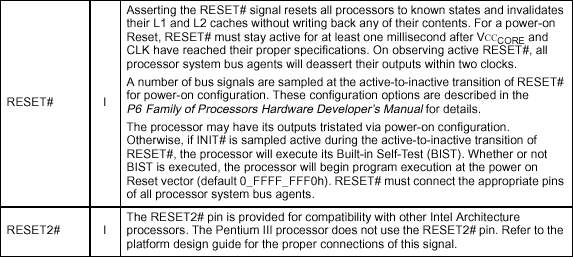FC-PGA Pentium III on Celeron PGA370/Slot1 Converter Cards
Features
By Thomas Pabst
published Getting An Socket370/Slot1 Adapter Card Ready For FC-PGA Coppermine - The Theory, Continued
- The 'RESET'-pin
Intel was quite humorous when designing the pin layout of Coppermine. To ensure that Coppermine was incompatible to Celeron the 'Reset#'-pin was placed at a new location (AH4) . The old location (X4) known from Celeron is called 'Reset2#', but it has no official function anymore. No processor in the whole world would ever start to work without a signal to 'Reset#' in the moment when you turn on your system. Placing 'Reset#' at a formerly 'reserved' pin of Celeron made sure that Coppermine would never work in Socket370.

- SlewCTRL and RTTCTRL
Frank picked those two GTL+-protocoll pins and suggested to pull them down. By default both pins are where Celeron used to have 'reserved'-pins, so that in Socket370 those pins are not connected and therefore 'high'. I have not enough documentation to give my own comment to it, but I know that my Slocket-card works just fine at up to 933 MHz with both of those pins left at 'high'. It might be safer to use pull downs though.

- Pin AM2
This pin, found in one of the corners of the Socket, is another way that Intel chose to make sure that Coppermine doesn't run in Celeron-sockets. 'AM2' is one of the 50 'ground' supplying pins of Celeron. Coppermine doesn't use this pin, but it doesn't like 0V or 'ground' on it. As soon as AM2 of Coppermine is connected to ground, the processor doesn't run. The datasheet does actually not mention a word about this behaviour.
Stay on the Cutting Edge
Join the experts who read Tom's Hardware for the inside track on enthusiast PC tech news — and have for over 25 years. We'll send breaking news and in-depth reviews of CPUs, GPUs, AI, maker hardware and more straight to your inbox.
Current page: Getting An Socket370/Slot1 Adapter Card Ready For FC-PGA Coppermine - The Theory, Continued
Prev Page Getting An Socket370/Slot1 Adapter Card Ready For FC-PGA Coppermine - The Theory Next Page Theoretical Summary
No comments yet
Comment from the forums
Most Popular

